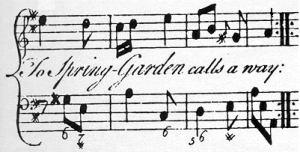Chamber music
Learning to play music was part of a middle- or upper-class education, so there was a steady demand for printed music that could be played at home by amateur musicians.
The genre that prevailed was the “Trio Sonata,” so-called because it was generally composed in three parts, for one (or two) treble instrument(s) and continuo’, as the drawing of the musical party at the Linleys’ illustrates.
The most commonly used instruments were the recorder and/or the flute, the violin and the oboe, which could often been played interchangeably. Title-pages commonly underlined such freedom of instrumentation.
There is manuscript evidence that the best-liked composers were not only Corelli, but also Handel. For instance, the largest number of compositions in the Sharp family’s music library was by Handel, whose works also ranked very high in the library of the Edinburgh Music Society.
Continuo
The bass was so called because it provided the melody instruments with continuous accompaniment suggesting the basic harmony and rhythm of the piece.
Continuo instruments (for instance, a harpsichord, a spinet, a lute or a theorbo) often improvised their accompaniment from the figured bass line in which the composer had written the figures specifying which chords were to be used. Keyboard players, in particular, would play the bass line with the left hand, and fill in the harmony with the right hand.

- figured bass
Thus, a figure of 5...

- some options for its realisation
- [click on the picture to enlarge it]
...meant that the interval of a fifth (e.g. from C to G), hence a triad (e.g. a C-E-G chord in the key of C major), had to be played.
Like the soloist(s), the continuo player was thus given scope to improvise within the framework imposed by the composer. Each performance was therefore bound to offer a different interpretation. For instance, the realisation of the figured bass in Rural Beauty might be written out as follows: Typically, the bass [beis] line was reinforced by a bass viol, a bassoon, a cello or a serpent.
In Zoffany’s painting of the Sharp family, the continuo instruments are linked by a compositional line.
Serpent
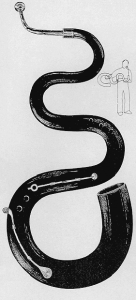
- A serpent
- [click on the picture to enlarge it]
A serpent is shown in Zoffany’s painting of the Sharp family.
Serpents were used to reinforce the bass line of continuo instruments.
They were also used in church.
- L’Aubade du serpent
- track 7 in Michel Godard, Le Chant du serpent, Média 7, CD LLL 37
Title-pages
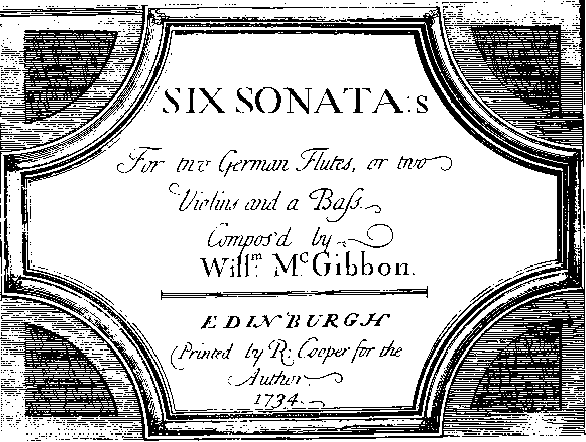
- Title-page
- Title-page of McGibbon’s trio-sonatas of 1734 (Rowe Library, King’s College, Cambridge).
[click on the picture to enlarge it]
The transverse flute, which came into general use after the 1720s, was referred to as the “German flute”, in contradistinction with the recorder or “common flute”.
George Frideric Handel
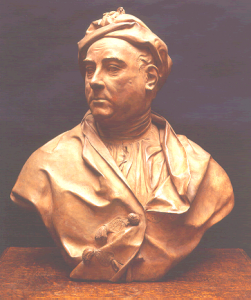
- George Frederic Handel
- Louis François Roubiliac, George Frederic Handel (The Foundling Museum/The Bridgeman Art Library)
[click on the picture to enlarge it]
One of the greatest “English” composers of the baroque period, Georg Friederich Haendel (Händel) was born in Germany on February 23, 1685. He was first trained in his native country. About 1706, he went to Italy, where he learnt to master the Italian style. When he returned to Germany in 1710, he became musical director to the elector of Hanover, the future King George I of Great Britain. Later in the same year he visited England - where his opera Rinaldo was very successful - and obtained a leave of absence from Hanover.
- G. F. Handel, Sonata in B Flat (1725-26)
- track 4 of the record Recorder Sonatas (n°RIC 031007, 1985).
Frédéric De Roos, recorder
Guy Penson, harpsichord
Philippe Pierlot, bass viol
Handel soon made London his permanent home, became a British subject in 1727, and gradually preferred the anglicised form of his name. Although initially he continued to write in the Italian style, and composed many fashionable Italian operas in London, the cosmopolitan musician also responded to the taste of his audience for English-language performances, and integrated the characteristics of English music into his works. Today he is best known for his English oratorios, unacted musical dramas with religious subject-matters and prominent use of the chorus, that he started writing in 1718. The most famous is the Messiah (1742), performed regularly for the benefit of the Foundling Hospital.
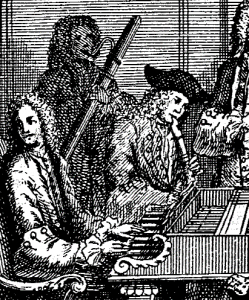
- The Modern Music Master
- Detail from the title-page of Peter Prelleur’s The Modern Music Master (London, 1731)
[click on the picture to enlarge it]
A prolific composer who depended not only on royal and aristocratic patronage, but also on the commercial success of performances in which he often bore considerable financial risk, Handel made outstanding contributions not only to English vocal secular and religious music, but also to instrumental music of various genres, such as chamber works, harpsichord suites, concerti, and orchestral music.
Handel, the Dettingen Te Deum (1743)
The victory of the English and Hanoverian troops over the French at the battle of Dettingen in the Austrian war of succession in 1743 was the occasion for Handel’s fifth Te Deum, commissioned by King George II, who had reputedly signalled himself by his bravery on the battlefield.
The work was composed within the English musical tradition, going back to Purcell, in the festive D major and related keys that suited the
traditionally associated with the theme of thanksgiving for the assistance of divine Providence in British history.
The Dettingen Te Deum can also be compared with a symphony anthem, with arias sung by soloists alternating with choral sections and instrumental and orchestral interludes, as in the bass [beis] solo and chorus Thou art the King of Glory.
Not only was the King deeply moved by the music, but the work proved so popular that it promptly superseded the earlier Te Deum that Handel had composed to celebrate the peace of Utrecht (1713).
- Thou art the King of Glory
- Basso solo and Chorus
- “Que Lou Di Lam”
- choir, François Bocquet, IT project manager GRECO (Grenoble Campus Ouvert), conductor Alain Desbrières. 381112 Maeudre, track 6
Thou art the King of Glory,
Oh Christ,
Thou art the everlasting Son
Of the Father.

